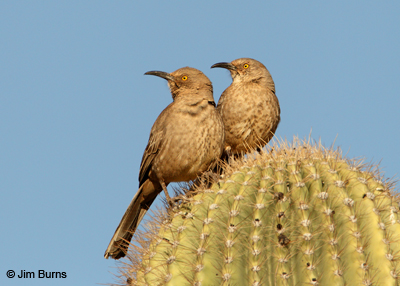
It’s that winter transition season of the year when it begins to stay lighter longer in the evening sooner than it gets lighter earlier in the morning. Read that sentence again, slowly, think about sunrise and sunset times, and it will make sense. I’ve just come in from my morning run, and I’m sitting at the kitchen island with breakfast and the newspaper (newspaper, how quaint in this day and age, right?), trying to warm up. The outdoor thermometer reads low forties. Outside the window our front yard is still pitch black. Then I hear him, so loud against the velvet silence of the unrisen dawn he sounds like he’s right on the window sill.
Beginning birders learn soon enough to associate the sharp, two syllabled “wolf whistle” call with our Curve-billed Thrasher, but it takes a little more experience to learn this common desert dweller’s sweet song. It is variously described as a rich and melodic warbling with abrupt phrases and few syllables. Vaguely reminiscent of Northern Mockingbird but much shorter and non repetitive, the beautiful Curve-billed song is heard most often at this season, sung from a perch that is high but not always exposed, and there may be minutes between performances, particularly before sunrise.
I hear perhaps only half a dozen notes, then nothing. I finish the editorial page, all the letters about Governor Brewer’s spat with President Obama on the tarmac, before I hear him again. Perhaps a dozen notes this time, sharp at first, then trailing off into the remains of the night. Many sleep deprived people know only too well that mockingbirds often sing all night this time of year, but few are aware that Curve-billeds are early risers because they don’t recognize the seldom heard dawn song. I work through all the pros and cons of trading Steve Nash before I hear the thrasher again, tantalizingly longer now as if he is warming up with the glint of first light in the eastern sky.
The pauses, or lapses if you will, are so long, the music so intermittent, that each time he begins anew it toggles my consciousness anew to just how unexpected this nuanced and lilting song seems, knowing it comes from the same feathered throat that explodes into the harsh, strident contact and alarm whistle for which his species is so well known. My mind contemplates new, unused adjectives for the song. I wonder exactly what he is doing during the long interludes. I know he is at or near the top of our big olive tree, and I know he hasn’t moved, though some phrases seem slightly farther away, most likely because he turns his head slightly to broadcast his territory to all points of the dawn.
As I finish reading about the atrocities in Syria, I put the paper down, glance at the window, and wait. I can see the silhouette of the olive tree now. As if on cue, the thrasher picks up again, still at his perch, his dulcet tones flowing down across the yard like the promise of the coming sunrise. A full minute perhaps. Politics, sports, man’s inhumanity to man, all fade into banality. The song is the touchstone for our humanity. The song becomes the light.
I pick up my binoculars, go out the back door and circle around the side yard. He is outlined on the highest branch, facing the fiery luminescence on the eastern horizon. I put the glasses on him, knowing what I will see because I have experienced it before. Though his bill is closed, his throat is moving, expanding, then contracting, the small feathers and faint moustachial marks puffing out, then receding. His song fills me. His song chases the night. His song reminds me why it is that I am a birder.